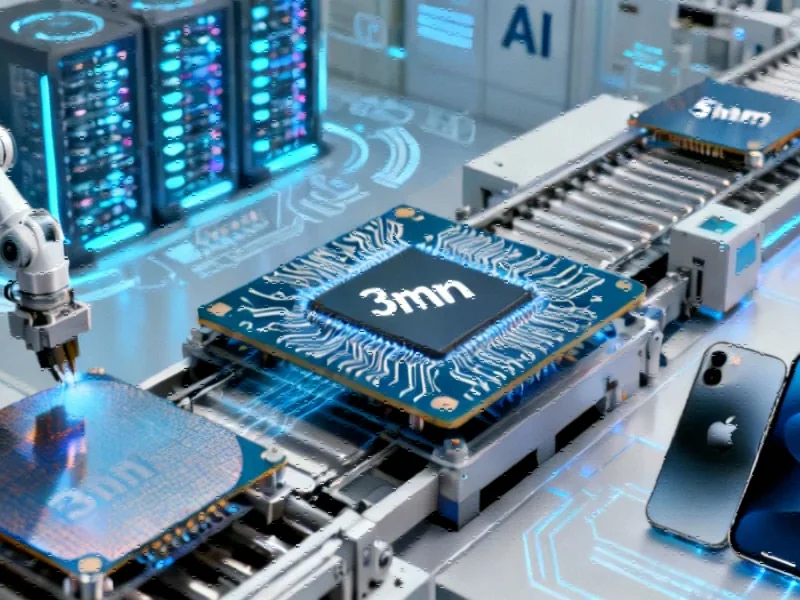TSMC Shatters Records with Advanced Chip Manufacturing
Taiwan Semiconductor Manufacturing Company (TSMC) has delivered an extraordinary financial performance that underscores the insatiable global demand for cutting-edge semiconductor technology. The world’s leading foundry reported third-quarter 2025 revenue of approximately $27.6 billion, representing a staggering 34% year-over-year increase, while profits surged nearly 40% to reach $12.6 billion. This remarkable growth trajectory demonstrates TSMC’s unparalleled position in manufacturing the most advanced chips powering today’s digital transformation.
The 3nm and 5nm Revolution Driving Performance
At the heart of TSMC’s success lies its technological leadership in advanced process nodes. The company’s 3nm manufacturing process, which produces some of the world’s fastest and most power-efficient chips, contributed 23% of wafer revenue this quarter. While this represents a slight decrease from 26% earlier in the year, it reflects the natural product cycle as production ramps up. More significantly, the mature 5nm node continues to demonstrate remarkable staying power, accounting for 37% of total wafer revenue. Combined, these two advanced technologies represent the majority of TSMC’s output and form the foundation for products from industry giants including Apple, Qualcomm, and Nvidia.
The strategic importance of these manufacturing processes cannot be overstated. As recent technology advancements continue to push the boundaries of what’s possible in computing, TSMC’s ability to consistently deliver these sophisticated nodes has become increasingly valuable to the global technology ecosystem.
AI Sector: The Primary Growth Engine
The artificial intelligence revolution has emerged as the single most important driver of TSMC’s record-breaking performance. Companies across the AI value chain, including Nvidia, AMD, and Broadcom, depend almost exclusively on TSMC to manufacture the high-performance GPUs and specialized AI processors that power everything from massive data centers to next-generation personal computers. As AI models grow increasingly complex and demanding, the need for more efficient, powerful chips continues to accelerate—a trend that plays directly to TSMC’s strengths.
This AI-driven demand reflects broader industry developments that are reshaping the semiconductor landscape. The computational requirements of training and running sophisticated AI models have created an unprecedented need for advanced semiconductor technology, positioning TSMC as an essential partner for virtually every major player in the AI space.
Apple’s Role in Sustaining Advanced Node Demand
Beyond the AI sector, Apple remains a cornerstone of TSMC’s advanced manufacturing business. The Cupertino-based company’s latest A-series and M-series processors, which power current-generation iPhones, iPads, and Macs, exclusively utilize TSMC’s 3nm technology. This partnership delivers tangible benefits to consumers through improved battery life and enhanced performance while ensuring consistent, high-volume demand for TSMC’s most advanced production capabilities.
Meanwhile, mobile chip designers Qualcomm and MediaTek are increasingly adopting advanced nodes for their latest offerings, ensuring that both the premium smartphone market and emerging AI applications continue to drive utilization of TSMC’s production lines. These related innovations in mobile computing contribute significantly to maintaining TSMC’s manufacturing volumes at near-capacity levels.
Strategic Positioning for Future Technology Waves
Looking ahead, TSMC appears exceptionally well-positioned to maintain its leadership position. The company is already advancing its next-generation manufacturing processes, including the highly anticipated 2nm node and refined N3E technology, both promising substantial improvements in energy efficiency and computational performance. These developments come at a critical time as global market trends continue to emphasize the importance of computational efficiency across all segments of the technology industry.
The broader implications of TSMC’s performance extend beyond the semiconductor sector, influencing everything from global economic indicators to investment patterns in advanced technology. Similarly, the company’s success reflects the strategic decisions being made by major financial players who recognize the fundamental importance of semiconductor manufacturing in the modern economy.
Broader Industry Context and Competitive Landscape
TSMC’s record quarter occurs against a backdrop of significant transformation across the technology sector. Competitors and partners alike are making strategic adjustments, including significant cloud infrastructure shifts that ultimately drive demand for advanced semiconductors. Meanwhile, changing investment patterns, such as those reflected in the ongoing evolution of investment vehicles, continue to shape the capital environment in which semiconductor companies operate.
The undeniable momentum behind advanced chip manufacturing is further highlighted by parallel industry reporting that confirms the strategic importance of TSMC’s technological leadership. As the digital transformation of the global economy accelerates, TSMC’s ability to consistently deliver these sophisticated manufacturing capabilities will likely remain a critical determinant of technological progress across multiple industries.
Conclusion: Sustaining Leadership in a Competitive Market
TSMC’s extraordinary quarterly performance demonstrates the company’s successful execution in an increasingly competitive and strategically vital industry. The convergence of demand from artificial intelligence, mobile computing, and traditional computing segments has created a perfect storm of opportunity that TSMC has capitalized on through technological excellence and manufacturing scale. As the company continues to advance its process technology roadmap and expand its manufacturing capacity, its position as the foundational enabler of digital innovation appears more secure than ever.
The semiconductor industry’s ongoing evolution suggests that TSMC’s current success represents not merely a cyclical peak but rather a structural shift in the global technology landscape—one where advanced manufacturing capabilities increasingly determine which companies and countries lead in the digital age.
This article aggregates information from publicly available sources. All trademarks and copyrights belong to their respective owners.
Note: Featured image is for illustrative purposes only and does not represent any specific product, service, or entity mentioned in this article.
